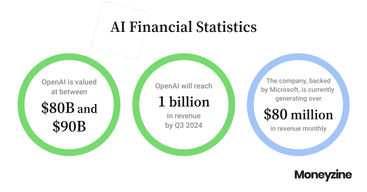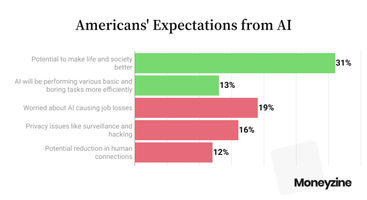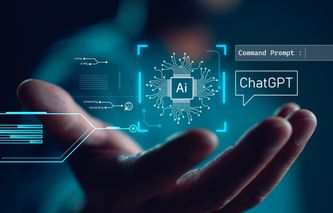In today's rapidly evolving technological landscape, artificial intelligence (AI) has emerged as a groundbreaking field, revolutionizing industries, and enhancing our daily lives. AI, often associated with intelligent machines and data-driven decision-making, has seen remarkable growth in recent years.
However, it's important to note that despite these advancements, the elusive dream of achieving a true AI, one that emulates human-like intelligence, remains unattained. The artificial intelligence statistics from the team at Moneyzine below delve into the world of AI, and shed light on the industry's remarkable growth while acknowledging the ongoing quest for the elusive true AI.
Top 10 Artificial Intelligence Statistics for 2026
OpenAI is valued at between $80 and $90 billion
OpenAI will reach one billion in revenue by Q3 2024
Nvidia stock has jumped by 200% in 2023 thanks to AI.
Globally, 73% of people do not feel safe in self-driving cars.
80% of polled executives believe that AI will lead to changes in employee roles and skills.
Clerical work stands out as the occupational category most vulnerable to technological disruption.
78% of Chinese citizens have a notably positive view of AI products and services.
The training process for AI models can result in emissions of carbon 25 times greater than that of an individual taking a one-way flight from New York to San Francisco.
Training a large language model in 2022 is 160 times more expensive than doing the same in 2019, just three years ago.
Bill Gates sees the development of AI as fundamental as the microprocessor.
AI Market Size and Financial Statistics
.png)
1. Baidu is the largest owner of active machine learning and artificial intelligence (AI) patent families worldwide.
In fact, the company has 13,993 active patent families. Tencent is in second place, with 13,187 active patent families owned, and IBM is fifth, with 9,500 active patent families.
Now, a patent family helps an inventor or organization secure their AI technology globally, ensuring that their innovations are legally protected in multiple jurisdictions. It also serves as a kind of first come first serve approach to tech usage, since it is now exclusively owned by a company.
2. OpenAI is valued at between $80 and $90 billion.
The AI startup responsible for ChatGPT, is reportedly in discussions with investors regarding the sale of its existing shares at a significantly higher valuation compared to a few months ago.
The potential deal could lead to an increase of value for OpenAI, between $80 billion to $90 billion, making it one of the world's most valuable private companies. This surge in valuation is largely attributed to the success of ChatGPT, which has sparked widespread enthusiasm for AI startups. OpenAI's rapid increase in value is further evident by its recent $300 million share sale earlier this year at a valuation of $30 billion.
3. OpenAI will reach one billion in revenue by Q3 2024.
Statistics on artificial intelligence companies show that OpenAI is poised to exceed $1 billion in revenue within the next year, primarily from the sale of AI software and its associated computing capacity.
This is a substantial increase from its earlier projection of $200 million in revenue for the current year. The company, backed by Microsoft, is currently generating over $80 million in revenue monthly, a significant jump from the $28 million it generated in the entirety of the previous year, according to a report by The Information.
4. Nvidia stock has jumped by 200% in 2023 thanks to AI.
The financial statistics on artificial intelligence show that the impetus behind this surge stems from Nvidia's critical role in the AI market, where its GPUs are indispensable for powering advanced AI tasks. However, this meteoric rise may leave potential investors contemplating the value of entry.
Nvidia’s stock is one of the best for day trading, and if you believe in the continued expansion of AI technologies and their indispensable role across industries, then Nvidia remains a compelling choice.

5. In 2022 the U.S. saw $47.4 billion in private AI investment.
In 2022, the U.S. saw a staggering $47.4 billion in AI investment, dwarfing the next highest country, China, which received $13.4 billion. Furthermore, the U.S. continues to lead in the creation of new AI companies, with 1.9 times more than the European Union and the United Kingdom combined, and 3.4 times more than China.
6. In 2022 $61 billion was invested into AI-led medical and healthcare sectors.
Artificial intelligence stats also show that another $5.9 billion for data management, processing, and cloud, and $5.5 billion for Fintech. However, most AI focus areas experienced a decrease in investment compared to 2021, in line with the overall trend in AI private funding.
Furthermore, in the past year, three noteworthy AI investment events include GAC Aion New Energy Automobile, a Chinese electric vehicle manufacturer securing $2.5 billion in funding, Anduril Industries, a U.S. company specializing in defense technology and border surveillance, raising $1.5 billion in a Series E funding round, and Celonis, a German business-data consulting company, securing a $1.2 billion investment.
7. Robotic process automation is one of the most common applications of AI technology (39%).
Incorporated within businesses, the AI capabilities with the most widespread adoption encompass robotic process automation (39%), computer vision (34%), natural language text understanding (33%), and virtual agents (33%).
Furthermore, in 2022, the prevailing AI application involved enhancing service operations for optimization (24%). Other prevalent use cases included the development of new AI-driven products (20%), customer segmentation (19%), analytics for customer service (19%), and enhancing existing products through AI (19%). It's worth noting that automated trading platforms also played a significant role in AI adoption within certain sectors.
AI Job Market and Public Opinion
8. In high-income countries, approximately 5.5% of total employment is at risk of automation.
A UN study, along with verified statistics about losing one’s job to artificial intelligence, indicate that the impact of AI on job displacement varies significantly based on a country's economic development and technological disparities.
In high-income countries, approximately 5.5% of total employment is at risk of automation, while in low-income countries, only about 0.4% of jobs face this risk. However, the potential for job augmentation through AI is relatively equal across countries. With appropriate policies and strategies, the ongoing technological transformation could potentially bring substantial advantages, especially for developing countries.
9. There is a growing interest in AI among policymakers in 127 countries.
The increasing number of bills related to "artificial intelligence" being passed into law, from just one in 2016 to 37 in 2022, demonstrates a growing interest and recognition of the importance of AI among policymakers in 127 countries.
Furthermore, the substantial rise in mentions of AI in global legislative proceedings, which has increased nearly 6.5 times since 2016 across 81 countries, suggests that AI is becoming an increasingly central topic of discussion and regulation on a global scale. Governments worldwide are actively addressing AI-related issues and seeking to shape policies and regulations to address the challenges and opportunities presented by artificial intelligence.
10. Globally, 73% of people do not feel safe in self-driving cars.
Furthermore, according to the statistics about artificial intelligence gathered by Pew Research, 26% of Americans believe that driverless passenger vehicles are a positive societal development.
Many people are not yet accustomed to the idea of autonomous vehicles and may have misconceptions about how they work, their capabilities, and their limitations. This lack of understanding can breed apprehension.
11. Of those Americans who are excited about AI, 31% are most excited about the potential to make life and society better.
Another 13% believe AI will be performing various basic and boring tasks more efficiently. Conversely, those expressing concern are primarily worried about AI causing job losses (19%), privacy issues like surveillance and hacking (16%), and the potential reduction in human connections (12%).

12. 80% of polled executives believe that AI will lead to changes in employee roles and skills.
Further, IBM artificial intelligence statistics from 2023 also show that more than three-quarters of executives state that entry-level positions are already being influenced by generative AI, while only 22% express the same regarding executive or senior management roles.
It should be noted, however, that the above numbers are relevant to the 28% of CEOs in the 2023 IBM CEO Study that have evaluated the potential influence of generative AI on their existing workforce.
13. Executives anticipate that around 40% of their workforce will require reskilling by no later than 2026.
This refers to the fact that almost 1.4 billion people globally will need some sort of reskilling when it comes to AI and automation.
However, do note that reskilling efforts are primarily focused on augmenting job roles rather than replacing them, with artificial intelligence statistics from 2023 showing that an average of 87% of executives expect this approach. The emphasis on job augmentation is particularly high in procurement (97%), risk and compliance (93%), and finance (93%), while it slightly drops in marketing (73%) and customer service (77%).
14. 83% of executives believe that generative AI will fundamentally transform the way their organizations operate.
Artificial intelligence statistics show that executives believe AI will change not only the workforce, but how organizations work as well.
According to IBM, over the past three years, those considering the operating model as the primary driver of enterprise transformation have achieved higher levels of profitability, revenue growth, innovation, and employee retention. In fact, this group outperforms their competition by 44% more frequently than those solely focused on skills development, which fares the worst.
15. Clerical work stands out as the occupational category most vulnerable to technological disruption.
Approximately 25% of tasks are deemed highly susceptible to automation, and over 50% fall under a medium-level exposure to technological change. In contrast, for other occupational groups such as managers, professionals, and technicians, a much smaller portion of their tasks face a high risk of automation, with about 25% falling under a medium level of exposure.
Clerical tasks, which often involve repetitive and routine work, are more susceptible to technological disruption, while other roles require skills and decision-making that are less easily automated.
16. Pesimists believe AI can replace 300 million full-time jobs…
The data and statistics on artificial intelligence gathered and reported on by Goldman Sachs predicts that AI has the potential to replace around 300 million full-time jobs. It's expected to affect a quarter of work tasks in the US and Europe, although it could also lead to the creation of new jobs and increased productivity. Moreover, AI has the potential to boost the total annual value of global goods and services by 7%.
17. …and AI might result in lower wages..
Carl Benedikt Frey, the Future of Work director at Oxford University's Oxford Martin School, points out the uncertainty surrounding the extent to which generative AI will replace jobs. He uses ChatGPT as an example to illustrate how AI can empower individuals with average writing skills to produce essays and articles. However, this increased accessibility to content creation may lead to more competition among writers, potentially causing a decline in wages unless there is a significant surge in demand for such work.
Another example of wage deflation is the fact that with GPS navigation, the value of knowing all the streets in a city decreased, leading to wage reductions for taxi drivers. In this case, lower wages were the consequence, not a decrease in the number of drivers.
18. …but optimists believe things will even out.
However, contrasting viewpoints suggest that technological advancements since the 1980s have displaced workers more rapidly than they've generated new job opportunities. This indicates that the short-term impact of generative AI might be disruptive to employment.
19. There is a (slight) average increase in AI-related job postings.
Artificial intelligence facts and data show that the need for professional skills related to AI is on the rise in nearly every sector of the American economy. In all sectors where data is available, except for agriculture, forestry, fishing, and hunting, there has been an average increase in AI-related job postings, from 1.7% in 2021 to 1.9% in 2022.
20. 78% of Chinese citizens have a notably positive view of AI products and services.
In fact, the statistics on artificial intelligence show that they believe that AI tech offers more benefits than drawbacks. Conversely, Americans are less enthusiastic, with only 35% holding the same view.
Furthermore, men generally exhibit more positive attitudes toward AI products and services than women, as indicated by the 2022 IPSOS survey, where men are more likely to believe in the positive impact of AI, find it helpful in their lives, trust AI-using companies, and see the benefits outweighing the drawbacks.
Development and the Future
21. Bill Gates sees the development of AI as fundamental as the microprocessor.
Bill Gates, the co-founder of Microsoft, has emphasized the significance of artificial intelligence (AI) as one of the most pivotal technological advancements in decades. In a recent blog post, Gates likened AI's importance to that of the microprocessor, personal computer, Internet, and mobile phone.
He asserted that AI will bring about transformative changes in how people work, learn, travel, access healthcare, and communicate. Notably, Microsoft, where Gates still continues to serve as an advisor, made a substantial multibillion-dollar investment in the AI development team in January 2023.
22. AI and machine learning has shifted from academic theory to practical industrial usage.
Prior to 2014, artificial intelligence trends revolved around the majority of significant machine learning models being developed by academic institutions. However, in recent years, industry has surged ahead, with 32 significant machine learning models produced in 2022 compared to only three from academia.
The development of cutting-edge AI systems now heavily relies on substantial resources, including vast amounts of data, computational power, and financial investments, which are more readily available to industry players as opposed to nonprofits and academic institutions.
23. The training process for AI models can result in emissions of carbon 25 times greater than that of an individual taking a one-way flight from New York to San Francisco.
However, there is promising progress in the field, with emerging reinforcement learning models like BCOOLER demonstrating the potential for AI systems to be harnessed for optimizing energy consumption and minimizing their environmental impact
24. Incidents of unethical AI usage have surged by 26-fold since 2012.
One of the more worrying artificial intelligence trends is the increase in unethical usage. Notable examples from 2022 encompass a deepfake video depicting Ukrainian President Volodymyr Zelenskyy in a false surrender scenario and the implementation of call-monitoring technology in U.S. prisons for inmate surveillance.
25. Training a large language model in 2022 is 160 times more expensive than doing the same in 2019, just three years ago.
In 2019, GPT-2, often considered one of the pioneering large language models, contained 1.5 billion parameters and was trained at an estimated cost of $50,000 USD. In contrast, PaLM, a prominent large language model introduced in 2022, boasted a colossal 540 billion parameters and was trained at a staggering estimated cost of $8 million USD.
This made PaLM roughly 360 times larger than GPT-2 and about 160 times more expensive. This trend isn't exclusive to PaLM alone; it's a broader pattern across the field, with both large language models and multimodal models steadily growing in size and cost.
26. The percentage of recent computer science Ph.D. graduates from U.S. universities focusing on AI has surged to 19.1% in 2021, up from 14.9% in 2020 and 10.2% in 2010.
AI career stats indicate a growing trend in specialization and career choices among AI professionals. Notably, the proportion of recent computer science Ph.D. graduates specializing in AI has risen to 19.1% in 2021, up from 14.9% in 2020 and 10.2% in 2010.
In terms of career paths, there has been a noticeable shift. In 2011, an almost equal number of AI Ph.D. graduates entered industry (40.9%) and academia (41.6%). In 2021, however, 28.2% went with the academic route, while 65.4% took industry jobs.
Conclusion
From the exponential growth in the size and cost of AI models to the increasing ethical concerns and the changing landscape of AI careers, these statistics collectively paint a picture of a field in constant flux.
The surge in AI investment, the varying global perspectives on AI, and the heightened focus on AI ethics underscore its expanding impact across diverse domains. AI's dual potential as a creator of opportunities and a source of challenges becomes increasingly evident, highlighting the need for responsible and forward-thinking AI development.
.png)



